THE LURE OF THE LOIRE – PART 2
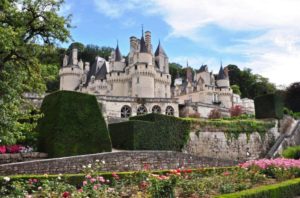
As we’ve seen in the previous post, the Loire Valley has a wealth of lively towns and villages, plus world renowned vineyards and enchanting scenery to keep any visitor happily engaged for numerous visits. Not only are the many châteaux a window into a world of grandeur and history, it’s possible to have a more personal experience of these historic places, as some now offer fantastic accommodation. What would a trip to the Loire be without great food? Fortunately, the region has any number of great restaurants to try—so you may need to seriously consider lengthening your stay to discover some of these memorable experiences!
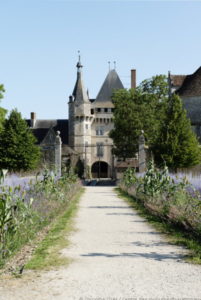
If you’ve already visited the big “headline” châteaux yet feel you’ve barely scratched the surface of this beautiful region—that’s true! Rest assured though that there are plenty of fascinating smaller châteaux, interesting villages, gardens and other places to explore.
It might have been the kings and royal court who first shaped the Loire Valley, but it is today’s residents, with their placid, easy-going joie de vivre and warm welcome who infuse a relaxed ambience across the Loire Valley and that of its scenic tributaries – the Cher, Indre, Vienne, Loir and Loiret. It’s easy to blend culture-crammed château visits with relaxing sojourns beside these rivers, or perhaps drifting downstream on one of the Loire’s traditional flat-bottomed boats, or pausing to enjoy some of the delicious, fresh produce of the region.
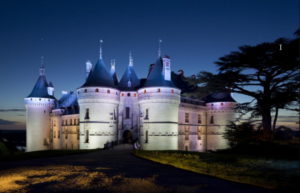
For garden lovers, the Loire is a treat indeed. I’ve already mentioned the wonderful gardens of Château de Villandry, but there are so many others, often the gardens and parks of châteaux.
One notable example is the Château de Chaumont which lies between Tours and Blois. Built originally in the 11th century to guard the border between Anjou and Blois, Chaumont owes its Renaissance design to Charles II, who was particularly fond of sculpted décor, so much of this adorns the façade. The château stands majestically on a raised hill just behind the village, from where it towers over the houses along the river.
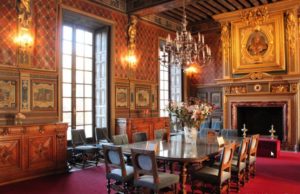
The original 11th century fortress-château was destroyed on the orders of Louis XI, since the owner had been part of a conspiracy against the growing royal power. However, the King later forgave the owner, who was granted permission to rebuild his château in 1465. By the middle of the 16th century, Chaumont belonged to Catherine de Medici, until she ‘persuaded’ the king’s mistress, Diane de Poitiers to exchange it for the beautiful Château de Chenonceau, following the death of Henri II from an injury sustained during a jousting tournament. Look out for the entwined ‘D’ of Diane de Poitiers, and the surrounding motifs of bows and quivers, hunting horns and other emblems of Diana, the Roman goddess of hunting.
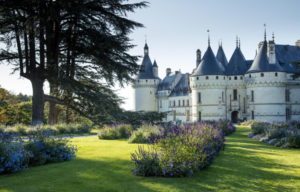
The Château de Chaumont is renowned for its International Garden Festival, held annually between April and October, and regarded as one of the best such festivals in France. Landscapers from around the world work together on designing some thirty gardens, with a different theme each year. Each one must create a nature-inspired artwork to show off their artistic imagination. The gardens can be visited at night during the festival, where impressive light shows create a magical atmosphere, revealing aspects of the garden that might not be seen by daylight.

The château’s park is huge and dotted with various large-scale sculptures, including one which is, in fact, a huge wooden walkway offering a panoramic view of the river. In recent years, a new garden has been designed in the spirit of a Chinese garden, with the idea that it will evolve over the years with pavilions, trees and stones being added. Conveniently, there are also three separate places to eat at the château: a bistro and two cafes. You also shouldn’t miss the stables. Built in 1877, they were regarded as the finest in Europe at the time, complete with carriages and Hermès harnesses.
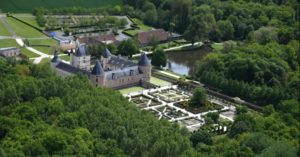
The Château de Chamerolles, 30 kms N.E. of Orléans, although a little further away from the main Loire Valley, is well worth a visit for the garden lover. Crossing a stone bridge over the moat takes the visitor into the beautiful Renaissance gardens. The concept was to recreate an authentic Renaissance-style garden using plants known to have been available in that era. Designed as a series of square parterres within a large parterre, each section has a different pattern of plantings, for example, one section is devoted to vegetables laid out in symmetrical beds and another includes lawns and seating, although most have patterns of low hedges of box or lavender, large trees and beds filled with a variety of flowering plants.
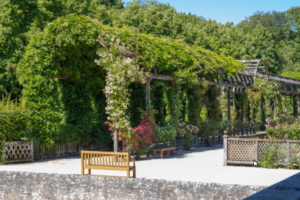
A long rose arch bordering the edge of the Renaissance garden adds a delicious scent as well as an abundance of flowers.
The château itself is very attractive. Originally built in the 12th century as a stronghold, it was purchased and largely rebuilt in the early 1500s by the chamberlain of Louis XII, who turned it into a château for pleasure and relaxation. Sadly, it was badly ransacked during WWII, and eventually purchased by the City of Paris, who failed to do anything with it. Eventually, it was handed over to the local council, whose heritage office not only restored this lovely château and gardens, but established a museum dedicated to the history of perfume making. Check local Tourist Offices for opening times.
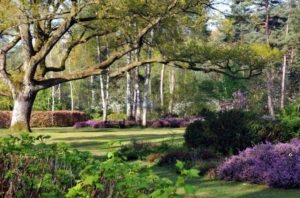
Not far from the Château de Chamerolles, about 30kms N.E. from Orléans, is one of the great garden centres of the Loire Valley, the Arboretum des Grandes Bruyeres. This 12 hectare private park is set within a 24 hectare nature reserve of the Forêt d’Orléans. The park contains eight gardens and the American and Asian arboretums. Its home to the French national collection of north American oaks, 400 magnolias, many -rhododendrons and flowering cornus (dogwoods), as well as 500 species and varieties of bruyeres (heathers), clematis, a labyrinth and rose tunnels, but most especially, 800 varieties of ancient roses. Open from March to November.
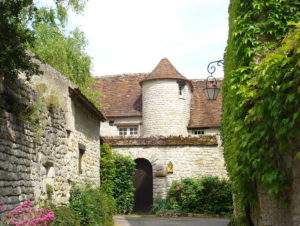
Another 20kms further on from Château de Chamerolles is the small village of Yèvre-le-Châtel, designated as one of ‘Les Plus Beaux Villages de France’. Perched on a high, rocky spur dominating the valley, it was originally a fortified site built in the 10th century. The remains of the château date from the 13th century, and built according to the defensive military architecture seen during the Crusades. Indeed, this fortress proved its worth during the Hundred Years War, since it was the only defensive stronghold north of the river Loire not to be captured by the English or the Burgundians. The fortress became redundant in the 15th century due largely to the advent of canon-power. A walkway enables you to circulate around the walls, and from the top of the towers, you’ll enjoy a vast panorama of the surrounding countryside.
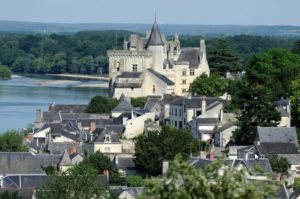
The village of Montsoreau lies 13kms east of Saumur heading towards Tours, on the banks of the river Loire. With its picturesque location and its stunning white tufa stone château, it’s easy to see why it’s designated as one of the ‘Plus Beaux Villages de France’. The château was made famous by the novel ‘La Dame de Montsoreau’ by Alexandre Dumas. After visiting the château, take a leisurely stroll along the pretty flower-filled narrow streets of the village. Just 4 kms south of Montsoreau lies the magnificent Abbaye Royale de Fontevraud, mentioned in the previous post. If you’re in the area on a weekend, another drawcard to Montsoreau is that it holds a delightful market every Sunday morning.
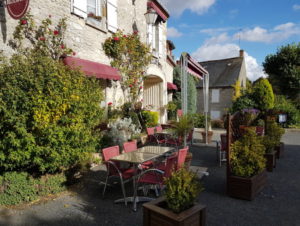
Yèvre-le-Châtel, with its ramparts, impressive fortified château, postern and the churches of the 11th century Saint-Gault and 13th century Saint-Lubin, is one of the most rewarding sites in the region to explore. The beautiful houses of the village, built from local limestone, the narrow, tree-shaded streets and flower-decked alleys make for a most enjoyable visit. In recent years, this very appealing village has become something of a magnet for painters, sculptors and visual artists of international renown.
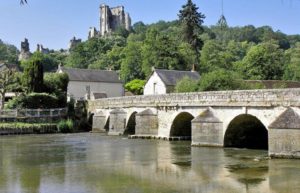
Another member of the ‘Plus Beaux Villages de France’ group is the village of Lavardin in the Loir-et-Cher department, some 40kms north of Tours. The Loir, a tributary of the Loire, flows through this picturesque medieval village, and the scenic banks with their weeping willows offer a lovely view of the Gothic bridge.
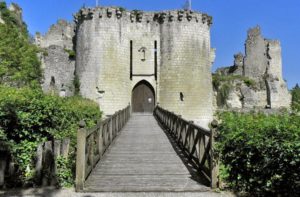
On a rocky outcrop overlooking the Limarde valley, its ruined château saw many battles over the centuries, and was finally partially dismantled on the orders of Henri IV in 1589. The village, nestled at the foot of its château, has retained its medieval aspect, and has several interesting buildings to discover during a very pleasant stroll through its delightful streets.
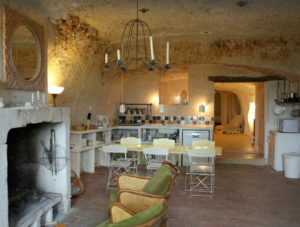
Lavardin is also remarkable for its numerous Troglodyte houses, a number of which are still inhabited, and every year at the end of September, the owners open their cave homes to the public during ‘Troglos Days’. These cave houses mingle with Renaissance houses for a unique effect. Check out the village’s Romanesque church of Saint-Genesius, which has splendid frescoes and murals dating from the 12th – 16th centuries. The Hotel de Ville has a small museum charting the history of Lavardin, providing an insight into the links of the village with the château.
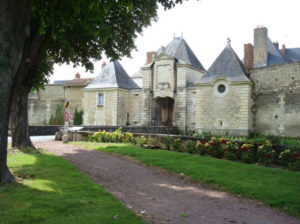
Although not designated as one of the ‘Plus Beaux Villages’, the small town of Richelieu, 18kms south of Chinon in the Indre-Loire, is well worth a visit. Named after the hugely egotistical Cardinal Richelieu, the town and the château that bore his name was constructed around 1625 by the most prestigious architect of the day, Jacques Lemercier. As architect to the king, Lemercier was also responsible for the domed church at the Paris Sorbonne and the enormous church of Saint-Roch in Paris.
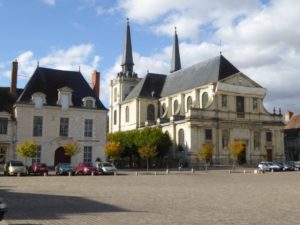
The château was demolished during the Revolution but the town, built in an innovative grid style, still has its surrounding ramparts, 3 monumental gates that lead into the town with its two symmetrical squares, one at each end, and numerous splendid mansions. The Richelieu Art and History Museum at the Hotel de Ville has a quantity of the Cardinal’s memorabilia, furniture and tapestries. In July every second year, actors in period costume bring the Cardinal’s era back to life at the ‘Cape et Épée’ (Cape and Sword) Festival. The town also has a number of well-marked, scenic cycle paths to encourage visitors to explore the region.
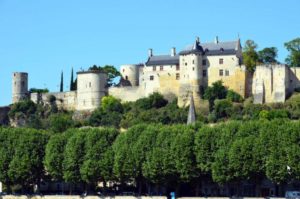
Perched on the banks of the River Vienne, some 30kms S.E. of Saumur, is the Forteresse de Chinon. Perhaps more than any other Loire Valley château, Chinon has the biggest fortress credentials, dating back to 954 when the first stone tower was constructed. A long and often blood-thirsty history followed. It was a favoured residence for a time of Henry II of England, but its moment of glory came with Joan of Arc who met the Dauphin, the future Charles VII, at the château in 1429 to convince him to give her an army to remove the English from French soil. The château was a prison in the late 16th century then fell into decay.
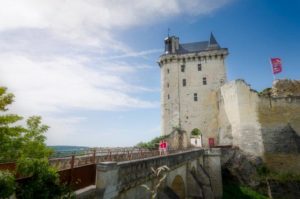
It recently underwent six years of intensive restoration to restore the whole site to its former military splendour. You can now climb up the numerous towers that rise up from the ramparts; there are well produced, interactive displays and information, and two rooms dedicated to Joan of Arc.
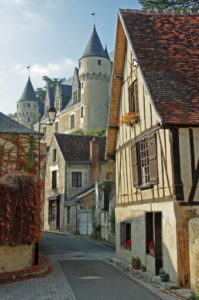
Located in one of the ‘Plus Beaux Villages de France’ is the Château de Montrésor located about 30kms to the south of Amboise.
This small château doesn’t appear on lists alongside the Loire’s bigger, better-known châteaux, however it is the picturesque setting of Montrésor which makes a visit here so magical.
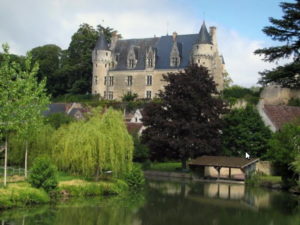
The tiny village of Montrésor sits on the banks of the River Indre, with weeping willows trailing its surface and cobbled streets lined with half-timbered houses grouped at the château’s base.
The château spans more than 1,000 years of history. You will discover a Renaissance interior furnished and decorated by the Polish Count Xavier Branicki, friend and financial advisor of Napoleon III, who purchased it in 1849. Following his death in 1877, the Château de Montrésor became a haven, a place of refuge for people torn apart by the territorial claims of Prussia, the Austro-Hungarian Empire and Russia. Although it’s still owned and occupied by the Count’s family, several rooms in the château are open to visitors.
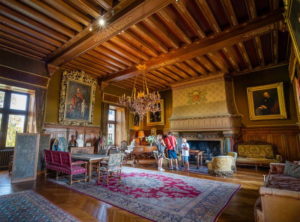
Your visit starts with a climb up a beautiful spiral staircase that the Count purchased at the Paris Exhibition of 1855, in order to access rooms decorated in a neo-Renaissance style, artwork from the Middle Ages. There is also an impressive library that holds rare Dutch atlases from the 16th century, regarded as the first great geographical maps of the world. In the grand salon is a piano on which Chopin composed a waltz for Countess Branicka. The château sits in beautiful, park-like grounds dotted with statuary that invites a relaxing stroll.
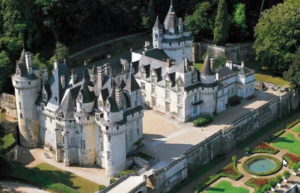
One of the most visually spectacular of all the châteaux is Le Château d’Ussé at the edge of the Chinon forest on the river Indre, a tributary of the Loire only 500m away, some 30kms east of Saumur and 15kms from Azay-le-Rideau. Like so many others, Château d’Ussé was originally built as a small fortress in the 11th century, but fell into ruins by the 15th century. Rebuilt in the 1440s and modified in the 17th century, Ussé changed hands numerous times, passing through branches of the French royal family and various royal courtiers. The current owner is the 7th Duc de Blancas. It’s the only private Loire château to have been continuously lived in by the same family for more than two centuries. Since 2007 it has been a UNESCO World Heritage Site.
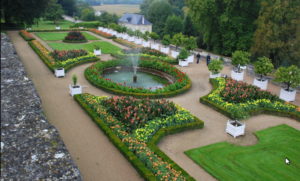
Famed for its picturesque setting, Ussé was the subject of a French railways travel poster in the 1920s, and was the main inspiration for several Walt Disney “fantasy” castles, most notably ‘Sleeping Beauty’. The magnificent gardens were created by the great master landscaper, Le Nôtre, who was also responsible for the gardens of Versailles, while Vauban created the terraces.
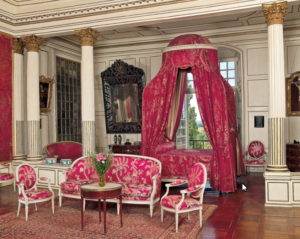
The renowned French writer Chateaubriand, who often stayed at Ussé, brought Cedars of Lebanon from the Holy Land to plant in the park, and the architect Mansart, created the majestic staircase. Other claims to fame are that Louis XIV and later the Emperor of Ethiopia, Haïlé Sélassié, visited and occupied the King’s Room. The Château is open daily from February to November.
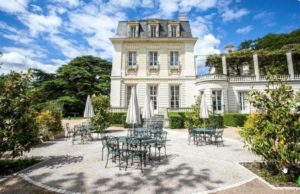
There are some great places to stay all over the Loire, and just 23kms on the other side of the Loire from Château d’Ussé, is Château de Rochecotte, an 18th century château that has been converted to a 4 star hotel and gourmet restaurant. Set in 24 hectares of beautiful gardens, the château is located in the village of Saint-Patrice near Langeais. It’s also ideally situated to discover many of the Loire chateaux and the renowned vineyards of Bourgeueil and Chinon.
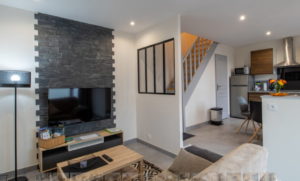
Ideal for a family or a group of friends, there are three recently opened gîtes on the estate of the Château de Chambord. With a 4 star rating, they are well furnished and fully equipped. Garden furniture and BBQs are provided, but their real appeal is insider access to one of the great monuments of France—once the visitors depart for the day, you have the site to yourself.
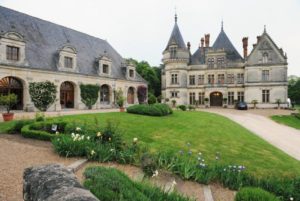
The Hotel Château de la Bourdaisière, between the rivers Cher and Loire 14kms east of Tours, is a 15th century château and a listed historic monument. It’s set in a 55 hectare park with stunning gardens, a pool and tennis court. It offers 25 rooms and 4 apartments, all beautifully furnished.
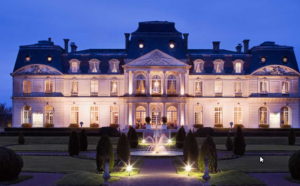
Another fabulous hotel worth checking out is Château d’Artigny set in 25 hectares on the river Indre, near the small town of Montbazon 15kms south of Tours. The current château is a fine example of Belle Époque architecture, built in 1912 by François Coty, the famous perfumer. The original structure was a fortress, underwent numerous transformations over the centuries and even survived the Revolution, before being rebuilt by Coty who aimed to create a mirror image of the 18th century Château de Champlâteux, north of Paris.
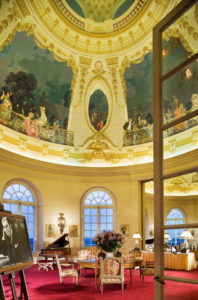
The château’s chapel is a scaled-down replica of the one at the Château de Versailles, while the most original and most beautiful room of the château is the rotunda on the first floor, topped with a cupola decorated with a trompe-l’oeil depicting one of Coty’s many lavish costume balls of the 1920s. The hotel has a gourmet restaurant showcasing produce from the property and neighbourhood, and a cellar with over 45,000 bottles.
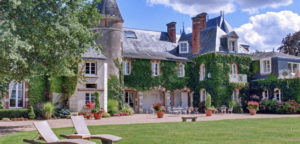
A great way to combine fantastic local food with a memorable place to stay is Domaine des Hauts de Loire, set in a beautiful forest near the town of Onzain, about 20kms N.W. of Blois. Built in 1860, this manor house is one of the Relais & Chateaux properties, and situated in the heart of the famous Vouvray wine area.
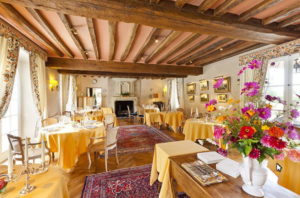
The on-site restaurants, including the Bistrot and the elegant 2 Michelin-star restaurant with chef Rémy Giraud in charge, focus on produce from the property itself and the local area, including honey from the Domaine’s beehives and produce from the vegetable garden. An added bonus: the hotel’s pastry chef makes chocolate on-site. Chef Giraud also runs cooking classes to introduce guests to his professional techniques and to learn about the culinary riches of the region.
We’ve only touched the tip of the iceberg with our exploration of the Loire Valley! There’s so much to see and do, not only with extraordinary, extravagant chateaux, but unforgettable places to stay and superb local food and wine. There’s far too much to fit into one or even two trips, but that’s the attraction with the Loire—it keeps drawing us back time and again.



Fascinating as always. Wouldn’t it be wonderful to stay in
one of those hotels? I wish!
So agree. To stay in some of these gorgeous places it might mean taking out a mortgage on the house!